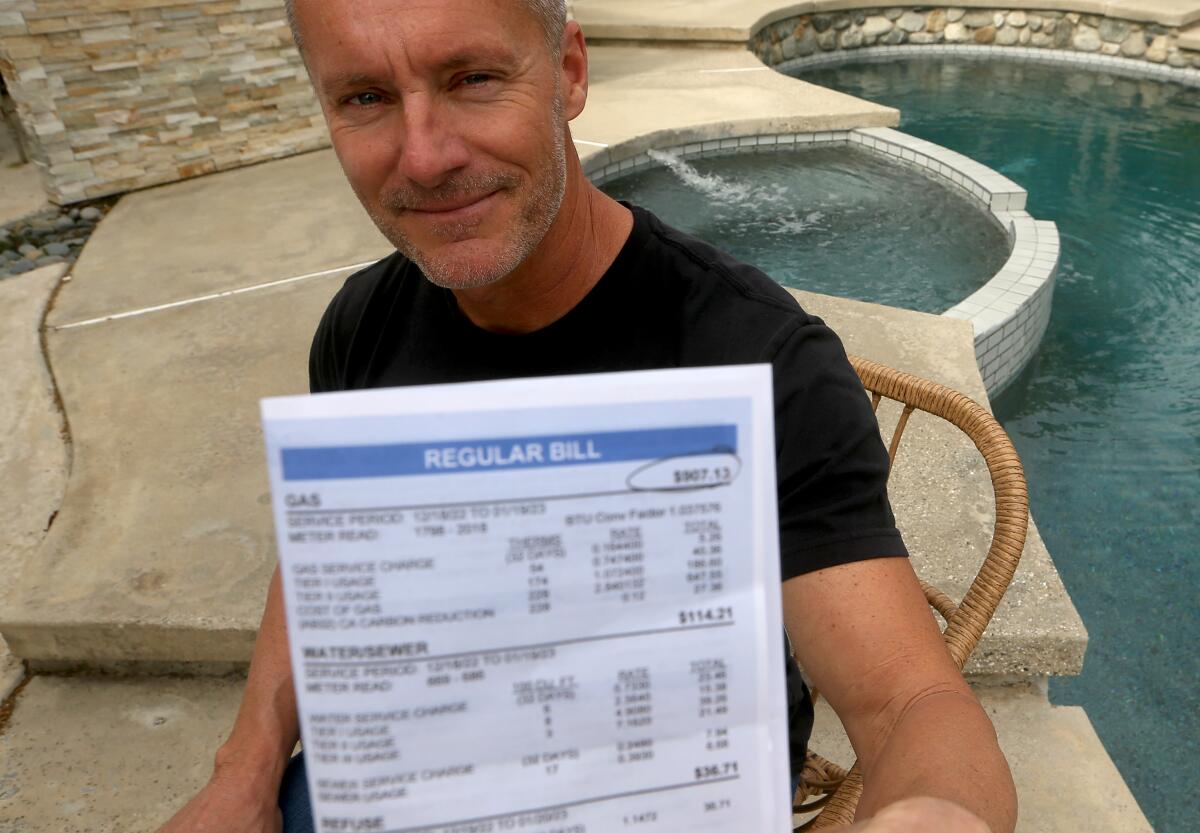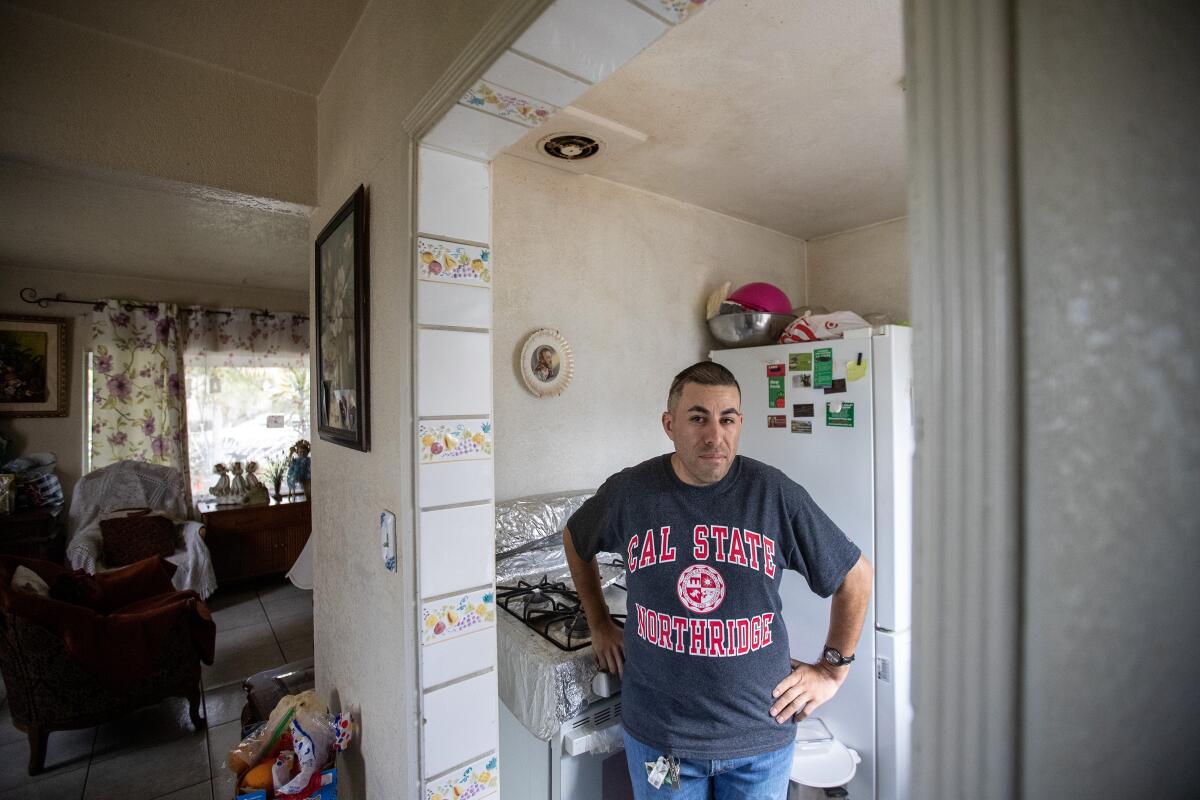The gas bill is $907.13? Sticker shock for Californians as prices soar

- Share via
Brent Eldridge had heard that prices for natural gas were high this winter, but nothing prepared him for how bad it could be.
When he opened the envelope from Long Beach’s utility department, he couldn’t believe the total: $907.13, nearly eight times higher than his bill at the same time last year.
“It made me want to puke,” said Eldridge, 48, a pastor.
Household budgets in the Golden State, already stretched thin as prices soar for everything from rent to eggs, are being pummeled by monster gas bills.
Southern California Gas Co. and Pacific Gas & Electric began warning customers in January that they would see higher bills after the wholesale price of natural gas hit record highs. But reality didn’t sink in for many customers until their bills started arriving later in the month.
SoCalGas said the average bill in January for its 21.8 million customers was about $300, more than twice the average of January 2022 — and homeowners with pools or many rooms to heat have reported being charged north of $2,000. PG&E has projected that bills in central and Northern California will be 32% higher this winter.
Both utilities say they don’t profit from higher bills because the cost of buying the gas is passed on to consumers, with no markup.
The sky-high numbers have spurred wrangling at kitchen tables across California, as families pick apart whether they ran the heater too much or took too many hot showers. Others have indignantly observed that the shocking bills followed a month of monastic living with the thermostat turned down and extra blankets on the bed.
Energy costs are a “crisis” that are walloping households already squeezed by inflation and the lingering effects of the COVID-19 pandemic, said Long Beach Mayor Rex Richardson, who called an emergency meeting of the City Council this month to approve extra assistance for customers who can’t pay.

Bills have soared “to levels that we haven’t seen in the last 20 years,” Richardson said. “We know families are struggling to make ends meet.”
Wholesale prices for natural gas in the West were 300% higher in December than they were in January 2022. Since December, prices have plummeted, but customers won’t see that reflected in their bills until late February or early March.
SoCalGas’ customer service lines have received more than 1 million calls this year, an increase of 15%, said Gillian Wright, a senior vice president and chief customer officer.
“The first message is: Don’t panic,” Wright said. “We are not disconnecting customers. We don’t plan to resume any disconnection of customers until much later. And second, there are options, and we can find solutions.”
She encouraged customers who can’t pay their latest bill to avoid wait times on the phone and start on SoCalGas’ website, where they can set up a 12-month payment plan or qualify for income-based discounts.
The charges have been particularly ugly for Californians on fixed incomes and those with health conditions that are affected by low temperatures. Some customers have put their bills on a credit card or have been able to pay only a portion of the total.
Bev Laumann, 71, and her husband received a $301.49 bill for January.
The Tustin couple are retired, and both have health issues that can be exacerbated by the cold. Laumann, who has fibromyalgia, has started wearing silk undershirts. The thermostat is set three degrees lower than usual, she said, and the couple are drawing the curtains to keep in the heat.
“I’m juggling things around to pay it,” she said.
Squeezed by the cost of medical care and prescription drugs, Laumann has ruthlessly trimmed the household budget, eliminating restaurant meals, trips to Starbucks — even the convenience of store-bought salad dressing. She’s baking her own bread and growing lettuce.
The couple have applied for a SoCalGas program that provides extra gas at the lowest rate for people with qualifying medical conditions. They aren’t below the poverty line, she said, “but if this keeps up every month, we will be.”
The shocking prices have left some households wondering whether there was a mistake on their bills.
Long Beach, which runs its own gas utility that also serves Signal Hill, included on a recent FAQ: “How do I know I don’t have a gas leak?” The answer explained that gas prices were at “historic highs,” and added: “But it’s always good to check!”
Gov. Gavin Newsom has called for a federal investigation into the wholesale price of natural gas, asking the Federal Energy Regulatory Commission to look into “whether market manipulation, anti-competitive behavior or other anomalous activities are driving these ongoing elevated prices” in the West.
Utilities generally buy and store gas in the summer, when prices are lower, then tap into their reserves in the winter, when wholesale prices rise.
Data from the U.S. Energy Information Administration show that SoCalGas’ daily inventory began to fall in November, at a steeper rate than the average of the previous five years. Had SoCalGas saved those reserves for later in the winter, the company could have offset some costs for customers, said Jamie Court, president of Consumer Watchdog, a Santa Monica nonprofit.
“They mismanaged their inventory controls, and that came at the expense of customers,” Court said.
SoCalGas’ stored reserves hit a six-year high in November, it told the Public Utilities Commission last week. Wright said November is typically milder, and the utility’s gas in storage on Nov. 1 met PUC requirements.
Natural gas is sold in million British thermal units, or MMBtu. Drawing from stored reserves helped SoCalGas pass along a cost of $34 MMBtu to customers, even as the market spiked to $50 in late December while the utility was purchasing gas for use in January, Wright said.
At a hearing at the PUC last week, SoCalGas and PG&E attributed rising costs to unusually cold weather in the Pacific Northwest and constraints on pipelines and gas storage facilities.
California imports about 90% of its natural gas. The U.S. Energy Information Administration recently pointed to reduced capacity in a West Texas pipeline that lowered the amount of gas flowing west. The report also found that natural gas storage in December in the Pacific region was 30% below the five-year average.
Even with a 20% discount provided through a program for low-income customers, Lionel Mares, 37, had a SoCalGas bill that topped $100, he told the commission. The increase, he said, “is not fair for working-class families.”
Mares is a part-time outreach worker for CicLAvia and lives with his retired aunt in Sun Valley. In Pacoima and other nearby neighborhoods, he said in an interview, elderly residents are facing the difficult choice of being cold at home or paying hundreds of dollars to run the furnace.
Mares said he got frustrated after reading the fine print of his bill, which said he was being charged $3.45 per therm (one unit of natural gas), up from 84 cents at the same time last year.
Mares paid the bill, since he “didn’t really have a choice,” he said. But to save money, he has started taking public transit or riding his bicycle for trips shorter than three miles and is eyeing other trims to his budget, including getting rid of cable TV.
Eldridge, the Long Beach resident with the bill of more than $900, said he and his wife have invested in solar panels to reduce their reliance on fossil fuels. They’ve switched out their gas-powered furnace and dryer for electric models.
His bill, eight times higher than last January’s, was an unwelcome reminder that his household is more reliant on gas than he would prefer, he said. He suspects the culprit is the whirlpool spa, which they run a few times a week in the winter.
“It’s not like it’s a 20-person Jacuzzi,” Eldridge said, “and it doesn’t take much to heat it up.”
Doug Doering, 61, of Santa Cruz knew it would cost him to heat the outdoor pool at his Palm Springs vacation home but decided to bite the bullet. Last winter, his monthly bill was about $980, a cost he thought he could handle. After all, he thought, what’s the point of a 25,000-gallon pool if you don’t swim in it?
Less than a week before his billing cycle closed, he received a warning from SoCalGas that rates were spiking. By then, the pool had been heated for more than a week. When the bill arrived, it was $2,770.
Doering called customer service to see if there had been a mistake. He said a SoCalGas representative explained that natural gas costs had soared in the West, then said he could predict the amount of his bill by checking the commodities market.
“Yeah, right, like we all have time for that,” Doering responded.
The experience, he said, felt like filling up at the gas station without knowing the per-gallon price. If SoCalGas had notified customers as soon as prices started to rise in December, he said, he would have acted differently.
“I wouldn’t have used the pool,” he said. “I would have turned down my water heater. I wouldn’t have turned my heat as high. I would have done all of the above.”
Times audience engagement editor Javier Panzar contributed to this report.
More to Read
Sign up for Essential California
The most important California stories and recommendations in your inbox every morning.
You may occasionally receive promotional content from the Los Angeles Times.










